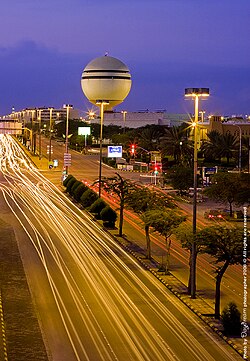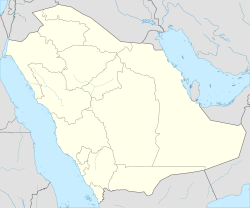Top Qs
Timeline
Chat
Perspective
Buraidah
City in Al-Qassim Province, Saudi Arabia From Wikipedia, the free encyclopedia
Remove ads
Buraydah or Buraidah (Arabic: بريدة) is the capital and largest city of Al-Qassim Province in north-central Saudi Arabia. Renowned as the agricultural capital of Saudi Arabia and often referred to as the food basket of the Kingdom, the city has a diverse agricultural output. It is especially famous for its date production, hosting one of the largest date markets in the world. In addition to dates, Buraydah produces a variety of fruits and vegetables, including figs, strawberries, grapes, and pomegranates.
This article needs additional citations for verification. (November 2012) |
The city is experiencing rapid economic growth, driven by infrastructure development, urban expansion, and increased investment in agriculture and logistics. Between 2018 and 2024, the number of commercial registrations in the Al-Qassim region surged by 14.5%, reaching 77,900 by August 2024, reflecting a vibrant increase in economic activity. [3]
In 2021, Buraydah was recognized by UNESCO as a Creative City in Gastronomy, becoming the first Gulf city and the second Arab city to receive this designation. [4]
Remove ads
Notable landmarks

- Buraydah Dates Market: It is the largest dates market in the world and is located in the center of buraidah.[5][6]
- Museum of Buraydah: it is on King Abdul Aziz Road next to King Khaled Beridp civilization, and there are days devoted for families and days for young people, and it has on display the area's heritage from all different aspects of life.
- Market trades and handicrafts
- King Khalid Cultural Center and Garden: in the vicinity of the Museum, a major Buraydah gardens open to visitors.
- Buraydah water tower: one of the most iconic landmarks in the city of Buraidah, Saudi Arabia. It is a towering structure that stands at a height of 40 meters and has a capacity of 5,000 cubic meters of water. The tower serves as a vital source of water for the residents of Buraidah, and it has become a symbol of the city's progress and development over the years.[citation needed] It is opened to visitors in the summer (festival). The nearby central city park is a popular excursion destination all year round.
- Buraydah Camel Market: The Buraydah Camel Market is the largest camel market in the world and is situated on the outskirts of Buraydah in Al-Qassim with thousands of camels for sale.
Remove ads
Roads and transport
Highways link Buraydah to the major cities surrounding it. It is 317 kilometers by highway to get to Riyadh, 450 km to get to Medina, and 250 kilometers to get to Ha'il. One can travel up to the border of Jordan, in a dual network of roads. There is now a railway line starting from Riyadh to Qurayyat operated by SAR with a modern rail station located at the northeast of the city. There is a train station in Buraidah with direct trains to Riyadh, Majmaa and Hail, and from there to Jouf as well.
Services at Qassim station
The Prince Nayef bin Abdulaziz International Airport west of Buraidah was built in 1964 and was expanded in 1964 over an area of 55,000 km2 with a capacity of 550,000 passengers. In 2009, international flights were launched. Flights to Dubai, Istanbul, Manamah, Kuwait, and Cairo are scheduled regularly along with domestic destinations.
Remove ads
Climate
Summarize
Perspective
Buraidah has a hot desert climate (Köppen climate classification BWh), with long, extremely hot summers and short, very mild winters. Precipitation is very low, which falls almost entirely between November and May, leaving summers extremely dry.
Population
The city has experienced very high rates of population growth. In 2022, Buraidah officially counted a population of 571,169 within the city limits.[9]
Education
Summarize
Perspective
Public schools
General Administration of Education in Qassim region enrolls over 118,589 students in primary, intermediate and high public schools in Buraydah. These students are enrolled in 381 primary schools, 211 intermediate schools and 131 public high schools.[10] 9754 students are enrolled in 77 private schools.[10] There are a number of international schools in Buraidah as well as many private kindergartens.
Colleges and universities

Qassim University is the largest higher educational institution in Al-Qassim region located in the west of Buraidah where more than 70,000 undergraduate and graduate students attend 38 colleges. Qassim University is among Saudi Arabia's largest 29 public universities in terms of the number of students. Besides Qassim University, there are three private higher education establishments in Buraidah. Mustaqbal University is a private university where 1234 undergraduate students study in engineering, computer science, dentistry, and administrative and human sciences colleges.[11] Buraydah College is another private higher education establishment where 2987 undergraduate students are enrolled in four faculties focused in dentistry, applied medical science, engineering and information technology, and administrative and human sciences colleges.[12] The third private higher education institute is Al-Ghad International Health Sciences Colleges.
Vocational training colleges
In addition to the technical training high school, Buraidah College of Technology and the College of Food and Environment Technology are two technical colleges managed by TVTC. Also, there are the International Technical Colleges operated in cooperation between TVTC and Laureate Vocational Saudi Arabia. Saudi Railway Polytechnic is a vocational training institute for railway technology located in the city.
Libraries
Besides Qassim University central libraries that hold more than 2,200,000 items,[13] King Saud public library is the main public library in Buraidah with around 30,000 titles and it is the oldest government public library in Saudi Arabia.[14] Sulaiman Al Rajhi Public library and the Literary club library are two other libraries open to the public in the city.
Remove ads
National Center for Vegetation Development and Combating Desertification
Summarize
Perspective




The goals of the center are to increase green spaces, combat desertification, rehabilitate degraded vegetation sites, raise awareness among the population to reduce negatively impacting agricultural practices and improve quality of life. The campaign is in line with the mission of the National Center for Vegetation Development and Combating Desertification.[15] The National Center, in collaboration with the National Water Company, has now completed the planting of one million trees in the Buraida oasis region. This oasis covers an area of more than 28 square kilometers in al-Qasim province and contributes to the Saudi Green Initiative (SGI) with its goals of planting 10 billion trees through the national tree planting program. The private sector is crucial in all tree planting projects across the Kingdom. These projects, monitored by the Center, aim to reduce carbon dioxide emissions. In addition, they also focus on protecting local species' ecosystems from extinction and promoting sustainable practices. [16]
To achieve this, the Vegetation Cover Center launched the National Tree Planting Program. This program operates in 13 regional branches in collaboration with the Ministry of Environment, Water and Agriculture. It includes a wide range of participants – government, private sector, non-profit organizations and volunteers. The common goal is to fulfill the objectives of the Saudi Green Initiative.[17]
The center focuses on the development and protection of vegetation sites, monitoring and rehabilitation of degraded areas, including the management and use of rangelands, forests and national parks. It is also about minimizing interference with vegetation cover, combating deforestation across the Kingdom and protecting natural resources and biodiversity.[18]
Remove ads
Notable people
See also
Notes
Further reading
Wikiwand - on
Seamless Wikipedia browsing. On steroids.
Remove ads


